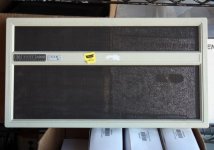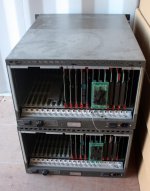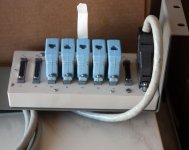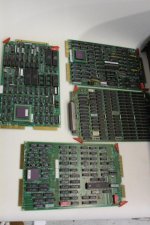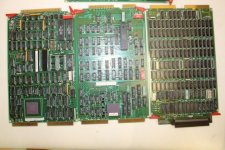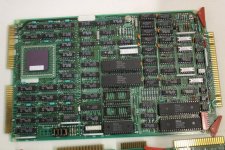I recently acquired two of each - when they were launched in 1982, the feds had a list of 16 countries that they could be sold to. Anywhere else and it was The Inquisition. I must start by giving credit to the HP Computer Museum. It has good write ups, excellent "Cliff's Notes" on testing and a comprehensive archive of documentation. That last turned out to be very important, as I shall relate.
It all came in an HP 19" rack. Space is tight and I've learned the folly of placing racks in my storage container, which is on the other side of town from my workshop and has no power. So, I deemed it best to remove the boxes from the rack on site.
The computers were not a problem. The front panels didn't want to pop off easily, but a little judicious leverage with a padded screwdriver and off they came. Four screws and they slid right out and were easily lifted onto some wheeled Metro shelving. This was looking easy - except I was wrong.
Turning my attention to the first of the HDDs, I removed screws and slid it out on its rails (it had been fitted using the 19" adapter kit). I then started looking for the little buttons, levers or whatever to disengage part of the rail from the rest - but couldn't find them. So, I brought a ridiculously powerful LED light into play, as an aide to my old eyes. Still nothing.
In desperation, I turned to the HP Computer Museum site and downloaded the Installation and Operation Manual, to my phone. I had already looked at it, at home, to look for anything about locking heads for transit. The good news is that, not only were the heads already locked for transit but whomever retired the drives put a little post-it note on each reading "heads locked". So, I can be reasonably confident that the heads have been locked since it was last powered down.
The bad news was that I failed to read the rest of the manual. It turns out that the slides for the rails don't separate. Instead, HP sold a special crane, that clamped to the top of the rack. To install a drive you first installed the adapter kit, then installed the rails. then you used the crane to winch up the drive, fully extended the rails, carefully winched the drive down and, when it was lined up, screwed the rails to the drive. Reverse the process to remove.
I didn't have the special crane, of course. Fortunately, the place that I was getting them from had an abundance of wheeled transports and lumber. With some carts, some 2x4s, some 4x4s and, in one case, some very robust cardboard, with a bit of fettling, I was able to place suitable wheeled platforms under each of the drives, enabling me to remove the screws fastening them to the rails and slide them out without them dropping and suffering impact shock. But, man, those things were heavy!
As things stand, the computers are on the back seat of my truck and the drives are still on site. I'll get them next week. The computers have all of the base cards, plus some I/O (HPIB, Serial, one of them has an Ethernet card) so seeing whether they pass a self test shouldn't be too onerous. But it might take a while. I've been wanting to get back to my pdp11/34, which will need space to work in. And much of that space is occupied by other projects (like a PET and an IBM 5110 that really should have first call on my attention). So, I may have to move backwards, in order to move forwards.
I will try to post some photos, though, as and when I can.
It all came in an HP 19" rack. Space is tight and I've learned the folly of placing racks in my storage container, which is on the other side of town from my workshop and has no power. So, I deemed it best to remove the boxes from the rack on site.
The computers were not a problem. The front panels didn't want to pop off easily, but a little judicious leverage with a padded screwdriver and off they came. Four screws and they slid right out and were easily lifted onto some wheeled Metro shelving. This was looking easy - except I was wrong.
Turning my attention to the first of the HDDs, I removed screws and slid it out on its rails (it had been fitted using the 19" adapter kit). I then started looking for the little buttons, levers or whatever to disengage part of the rail from the rest - but couldn't find them. So, I brought a ridiculously powerful LED light into play, as an aide to my old eyes. Still nothing.
In desperation, I turned to the HP Computer Museum site and downloaded the Installation and Operation Manual, to my phone. I had already looked at it, at home, to look for anything about locking heads for transit. The good news is that, not only were the heads already locked for transit but whomever retired the drives put a little post-it note on each reading "heads locked". So, I can be reasonably confident that the heads have been locked since it was last powered down.
The bad news was that I failed to read the rest of the manual. It turns out that the slides for the rails don't separate. Instead, HP sold a special crane, that clamped to the top of the rack. To install a drive you first installed the adapter kit, then installed the rails. then you used the crane to winch up the drive, fully extended the rails, carefully winched the drive down and, when it was lined up, screwed the rails to the drive. Reverse the process to remove.
I didn't have the special crane, of course. Fortunately, the place that I was getting them from had an abundance of wheeled transports and lumber. With some carts, some 2x4s, some 4x4s and, in one case, some very robust cardboard, with a bit of fettling, I was able to place suitable wheeled platforms under each of the drives, enabling me to remove the screws fastening them to the rails and slide them out without them dropping and suffering impact shock. But, man, those things were heavy!
As things stand, the computers are on the back seat of my truck and the drives are still on site. I'll get them next week. The computers have all of the base cards, plus some I/O (HPIB, Serial, one of them has an Ethernet card) so seeing whether they pass a self test shouldn't be too onerous. But it might take a while. I've been wanting to get back to my pdp11/34, which will need space to work in. And much of that space is occupied by other projects (like a PET and an IBM 5110 that really should have first call on my attention). So, I may have to move backwards, in order to move forwards.
I will try to post some photos, though, as and when I can.
Last edited:

